This article is being considered for deletion in accordance with Wikipedia's deletion policy. Please share your thoughts on the matter at this article's deletion discussion page. |
Max Silverstein | |
|---|---|
| Born | February 15, 1911 Chicago, Illinois |
| Died | May 7, 1942 (aged 31) at sea, Coral Sea |
| Allegiance | United States of America |
| Service/ | United States Navy |
| Years of service | 1932-1942 |
| Rank | Lieutenant |
| Unit | USS Sims (DD-409) |
| Battles/wars | Battle of the Coral Sea |
| Awards | Silver Star |
Max Silverstein was born in Chicago, Illinois, on February 15, 1911.
Silverstein was appointed midshipman at the U.S. Naval Academy on June 18, 1928. He was commissioned ensign on June 2, 1932 and went to sea in USS Chester (CA-27) on the 26th as an aircraft gunnery observer.
He was promoted to Lieutenant (junior grade) on June 2, 1935 and subsequently served in Chaumont (AP-45), USS Tattnall (DD-125), and Seattle (CA-11). After being promoted to lieutenant on March 13, 1940, later changed to date from August 1, 1939, Lt. Silverstein reported for duty as Engineer and Damage Control Officer in USS Sims (DD-409).
On May 7, 1942, during the Battle of the Coral Sea, Sims came under aerial attack. Though knocked unconscious by the first bomb, Lt. Silverstein quickly recovered and "coolly directed the securing of the boilers, the jettisoning of topside weights to preserve stability and the preparations for repairs to save the vessel from sinking." Lt. Silverstein died soon thereafter when Sims sank. For "his relentless determination and inspiring heroism . . . ," Lt. Silverstein was posthumously awarded the Silver Star medal.
Silverstein (DE-534) was laid down on October 8, 1943 at the Boston Navy Yard, Boston, Massachusetts; launched on November 8, 1943; sponsored by Mrs. Ruth B. Silverstein; and commissioned on July 14, 1944, Lt. Comdr. F.A. Reece, Jr., USNR, in command.

Albert Leroy David was an officer in the United States Navy during World War II and a recipient of two Navy Crosses as well as the Medal of Honor. He was awarded the Medal of Honor for his role in helping to capture the German submarine U-505, off the coast of French West Africa in June 1944.
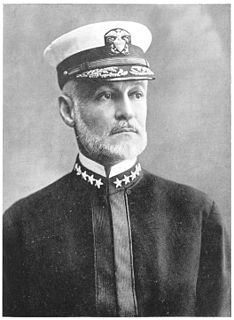
William Sowden Sims was an admiral in the United States Navy who fought during the late 19th and early 20th centuries to modernize the navy. During World War I he commanded all United States naval forces operating in Europe. He also served twice as president of the Naval War College.
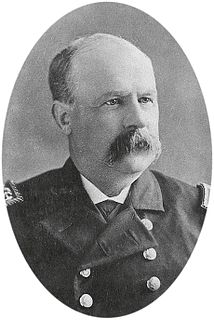
Commodore George Hamilton Perkins was an officer in the United States Navy during the American Civil War.

Charles Turner Joy was an admiral of the United States Navy during World War II and the Korean War. During the last years of his career, while fighting leukemia, he served as Superintendent of the Naval Academy. The destroyer USS Turner Joy (DD-951) was named for him.
Samuel Wood Bryant was an admiral in the United States Navy.
Lt. Comdr. Ralph Hickox was an officer of the United States Navy during World War II.

David Worth Bagley was an admiral in the United States Navy during World War II. He was also the brother of Ensign Worth Bagley, the only United States Navy officer killed in action during the Spanish–American War, and the father of Admirals David H. Bagley and Worth H. Bagley.
USS Sims (DE-154/APD-50), a Buckley-class destroyer escort of the United States Navy, was named in honor of Admiral William Sowden Sims (1858–1936), who pushed for modernization of the navy. She is the second ship in the United States Navy to be named USS Sims.
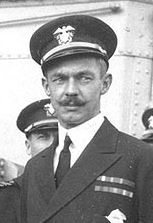
Walter Atlee Edwards was a Lieutenant-Commander in the United States Navy and a recipient of America's highest military decoration – the Medal of Honor.

Harry Brinkley "Brink" Bass was a U.S. Navy pilot who was twice awarded the Navy Cross for his heroic actions in the Pacific theater during World War II. Bass died over Saint Bonnet le Froid, in southern France when his plane was shot down by anti-aircraft fire. USS Brinkley Bass (DD-887) was named in his honor.

Jack William Wintle was a United States Navy Officer and a posthumous recipient of the Navy Cross, which was awarded for his actions in mid November 1942, during the Battle of Guadalcanal.
Lt. Edward Micka, enlisted in the United States Navy 19 June 1934. Appointed midshipman from the Navy at large the following year, he was commissioned ensign 1 June 1939.
Chief Machinist's Mate Eugene Blair was a United States Navy sailor of World War II who had a ship named for him.
Roy Orestus Hale Jr., born on 10 May 1916 in Monroe, Louisiana, graduated from the U.S. Naval Academy and was commissioned ensign in the United States Navy on 2 June 1938.
Arthur Edward Loeser ; appointed to the United States Naval Academy on 15 August 1923; and commissioned ensign on 2 June 1927.

Paul J. Register was a United States Navy officer killed in action during the attack on Pearl Harbor for whom two U.S. Navy ships were named.
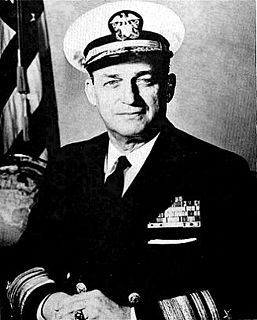
Charles Leroy Melson was a vice admiral of the United States Navy. His career included service in World War II, the Korean War, and the Cold War, command of the United States First Fleet and of the United States Taiwan Defense Command, and tours of duty as Superintendent of the United States Naval Academy and President of the Naval War College.
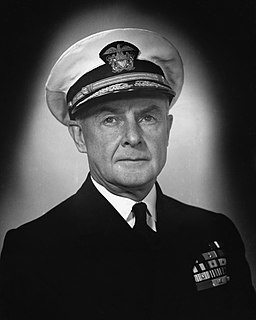
Vice Admiral Frank Jacob Lowry was an officer in the United States Navy who served in World War I and World War II. A 1911 graduate of the United States Naval Academy, he served on submarines during World War I. During World War II, he commanded the cruiser USS Minneapolis at the Battle of the Coral Sea, for which he was awarded the Navy Cross, and the Battle of Midway. He commanded the VIII Amphibious Force in the landings at Anzio and Southern France. He retired from the Navy in March 1950, and received a tombstone promotion to vice admiral due to his combat decorations.
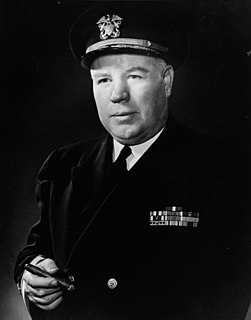
Vice Admiral Edmund Battelle Taylor was an admiral in the United States Navy. During World War II he saw service in the fighting in the Pacific, including the Battle of Cape Esperance, in which his ship, the USS Duncan was sunk, the Battle of Empress Augusta Bay and the Battle of the Philippine Sea. In the last months of the war he was the naval aide to the Secretary of the Navy, James Forrestal. After the war he commanded the Guantanamo Bay Naval Base and was commander of the Antisubmarine Defense Force, Atlantic Fleet, during the Cuban Missile Crisis.

Laurence Allen Abercrombie, was a decorated commander during World War II who reached the rank of Rear Admiral in the United States Navy. Admiral Abercrombie was thrice awarded the Navy Cross, United States military's second-highest decoration awarded for valor in combat.